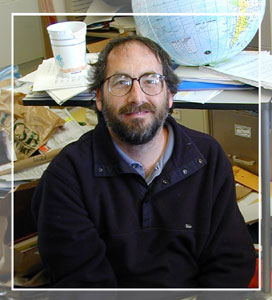Three of Professor David Siegel’s grad students in the Marine Sciences Program were recently awarded Earth System Science (ESS) Graduate Student Fellowships by NASA. A total of 181 applications representing 77 universities and educational institutions from 31 States were received and only 55 fellowships were awarded, so Dr. Siegel has reason to be proud of his students.
To quote the NASA web site , “the purpose of the Fellowship program is for NASA Earth Science to train a pool of highly qualified scientists in support of NASA’s mission to use the vantage point of space to understand and protect our home planet. NASA understands that the future of Earth science rests with today’s students, who will be tomorrow’s scientists and engineers. The 2006-2007 ESS Fellowships are given for an initial 1-year term and may be renewed annually for up to 3 years total, based on satisfactory progress as reflected in academic performance and evaluations made by faculty advisors. The amount of award is $24,000 per annum, including $18,000 student stipend and an allowance of up to $6,000 consisting of $3,000 for student expenses and $3,000 for university expenses.”
Congratulations to the following for their successful proposals:Kyle Cavanaugh: Remote Sensing of Kelp Habitats in the Santa Barbara Channel Using SPOT ImageryForests of giant kelp (Macrocystis pyrifera), found along the shallow rocky areas of the Santa Barbara Channel, are some of the most productive marine ecosystems in the world. The structure of kelp lends itself to aerial mapping; however, very few recent studies have used satellite mapping to calculate kelp coverage and none have done this with high spatial and temporal resolution. Through a partnership with Terra Image USA, UC Santa Barbara has the unique opportunity to access multiple dates of imagery of the Santa Barbara Channel from May of 2004 to the present. Using this imagery, we can create maps of kelp canopy coverage on a monthly basis and use them to understand the forcing of the kelp ecosystem by oceanographic processes on various spatial and temporal scales. We will parameterize predictive statistical and demographic models of kelp dynamics to predict changes in regional populations resulting from environmental forcing such as long term climate change. This work builds on existing projects at UCSB including the Santa Barbara Coastal LTER and the NASA supported Plumes and Blooms ocean color study.
Chantal Swan: Cycling of Colored Dissolved Organic Matter in the Open Ocean: Application of Photolysis Measurements to Global Satellite ObservationsThe proposed work is an integration of laboratory process studies with global remote-sensing data concerning open-ocean colored dissolved organic matter (CDOM). UVR photolysis of CDOM drives the global ocean surface distribution of CDOM seen from satellite. Light absorption by CDOM dominates UVR flux in the upper ocean, moderating photobiological processes and photochemistry of trace gases. Characteristics of CDOM relating to light exposure are observed in the ocean interior, and a quantitative understanding of photolysis will advance the potential utility of CDOM as a remotely-sensed ocean tracer. I propose experimental determinations of apparent quantum yield of CDOM photolysis on open-ocean samples and immediate application of these measurements to global CDOM data derived from NASA ocean color. Through this method, rates of photolytic loss, net production by bioremineralization, and seasonal entrainment of CDOM will be quantified such that an annual mixed layer budget for open-ocean CDOM is established.
Ted Eckmann: Validating Retrievals of Subpixel Fire Sizes and Temperatures from MODIS to Improve Understanding and Monitoring of FiresThe sizes and temperatures of fires strongly influence how they spread, the amount and chemistry of their trace gas and aerosol emissions, and their effects on ecosystems. Unfortunately, current remote sensing products leave large uncertainties in measurements of fire sizes and temperatures. However, preliminary results show that multiple endmember spectral mixture analysis (MESMA) can retrieve subpixel fire sizes and temperatures from MODIS and other sensors, and overcome many limitations of existing methods for pixel-level and subpixel fire measurements. This proposal describes a plan for exploring the following questions: 1) How effectively can MESMA retrieve subpixel fire sizes and temperatures from MODIS and other sensors? 2) How does MESMA compare to other methods for retrieving fire properties? 3) How can subpixel fire retrievals improve initialization and validation of fire spread models? 4) How sensitive are these subpixel retrievals and fire models to various inputs, how accurate are they, and how could they enhance scientific understanding of fires and their roles within the Earth system?


